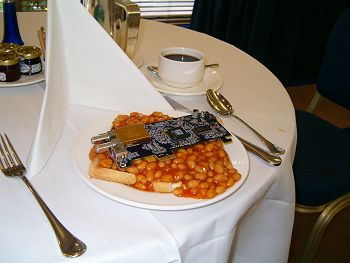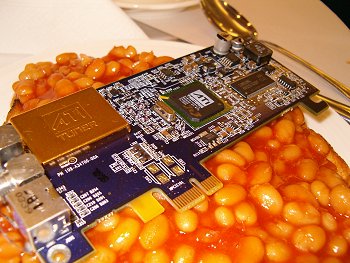ATI's Theater 550 PRO Video Processor - A First Look Over Breakfast
A week or so ago, as I was in London to test ATI's Radeon X700 XT, I had the chance to spend some time with a few guys from ATI's Multimedia group. The Multimedia group are the guys and gals responsible for products such as Radeon All-In-Wonder and TV Wonder. With Theater 550 PRO, the latest iteration of their class-leading video processing ASICs, making its debut recently, the Multimedia guys were in town as part of their world tour, showing off the 550 PRO to journalists, OEMs, systems integrators and anyone with a vested technological or sales and marketing interest in the hardware that'd listen.The Multimedia guys are passionate about their hardware, that much was evident as I spent more and more time talking to them about 550 PRO, TV Wonder, their USB products, All-In-Wonder, and also the competition (they're extremely knowledgeable about what NVIDIA and S3 do in the PC video processing space, almost as much as NVIDIA and S3 do themselves).
They're pretty bullish about 550 PRO at the moment, claiming a rough two-cycle lead over anything their competitors have announced or have in production, if anything exists within those competitor companies to compete with 550 PRO at all. ATI don't think there is.
Anyway, we got a sneak peak of Theater 550 PRO in action, demonstrated by ATI in dual-tuner fashion, using PCI Express variants of the initial basic tuner products.

Theater 550 PRO in action
Sadly, I wasn't allowed to take photos of the system used to demonstrate Theater 550 PRO, but a pair of 550 PRO tuner boards on PCI Express were installed into an ASUS mainboard using a decently clocked Pentium 4. Fed the same S-video signal from a DVD deck, via a splitter, the 550 PROs fed that into a special edition of Intervideo's WinDVD software, that accepts output from multiple 550 PRO tuners. The software shows the main selected tuner in full screen mode, with the second tuner showing as picture-in-picture in the corner. With the input video the same for each tuner, ATI demonstrated pulling out the video feed from each tuner separately, with the right piece of video going blank as the cable was removed.They then fed a single tuner a variety of video sources, using differing video quality, to see how the 550 PRO could handle cleaning up video streams that weren't of the highest quality. A snowboarding scene stood out for me, played back via the 550 PRO. High-motion and high-contrast between the whiter-than-white snow and background detail doesn't make for the cleanest of pictures at the best of times, but the 550 PRO seemed to have no problem doing real-time cleanup of the video source.
A quick demo, mostly to show two tuners in action simultaneously, that served its purpose, with ATI promising press samples as soon as they're ready for our own analysis. It certainly looks to do what ATI claim, on the surface. More when we get a full demo or a press sample (or two!).
Hijacking the 550 PRO over breakfast
The Multimedia guys invited me for breakfast the day after, to chat some more about 550 PRO, before they flew off to Amsterdam later that day for the next leg of their whirlwind tour. During breakfast the guys had to take a quick conference call, so we headed back upstairs, where I was left in the demo room with the demo hardware still hooked up. Spotting the Theater 550 PRO PCI tuner sample lying out, and a non-working 550 PRO on PCI Express next to it with the backplane removed, I couldn't resist grabbing them for some up close shots.But since we were in a hotel having breakfast, a good English breakfast I might add, some basic board shots on a plain background didn't quite sit right with me.
The working PCI version was up first, lying on the top of a quite exquisite plate of good old Heinz beans on some just-right toast. You can wipe the sauce off, right? A fresh cup of coffee, clean cutlery, arranged napkin and some jams and preserves in the background later and the staff in the breakfast lounge at the hotel were asking me what the hell was going on. "I'll eat the beans on toast, it's all good", I replied. Time for the PCI Express version now. We're OK this time, it was the demo sample that didn't quite work, that press got to hold and look at up close. A little tomato sauce wouldn't matter much.
You can see the ASIC in the centre of the board. 550 PRO uses a mandatory 16MB buffer, so on the test board Samsung get the module duties with a single K4D261638F DRAM device, rated to 250MHz (TC40 variant). There's also the Microtune MicroTuner to feed it with TV signals. It's a customised MT2-series tuner from what I can make out, but I'm not 100% sure.
The ASIC is a ~20M transistor (about the same as a full GeForce256) device made on TSMC's 130nm process. It features dual bus interfaces, PCI Conventional and PCI Express 1X, including the PCI Express interface basically ripped straight from ATI's R(V)4xx products and transplanted into the 550 PRO's design and layout.
Many of the 550 PRO's transistors are dedicated to the analogue video circuitry that processes analogue video data direct from the Microtune tuner. What's amazing is that 550 PRO was signed off as a working, retail-ready hardware product on the first spin of the silicon. Some low level gate tweaking using specialist tools at a silicon analysis firm, to slightly enhance the quality of the analogue circuitry, was done, with ATI then sending the tweaks back to TSMC to be incorporated into a final spin, 550 PRO's second, that's to be sold in retail 550 PRO-based hardware worldwide.
ATI are quite proud of the fact it was done in a single revision, with only a very minor respin for the quality they were happy with.
We should have samples for review pretty soon, and I should point out that Theater 550 PRO tuner boards, as you see in the above photographs, are not the basis of a good nutritional diet. No matter how tasty they look with some Heinz on toast.
I'll leave you with some more hot T550P-on-bean action.
















